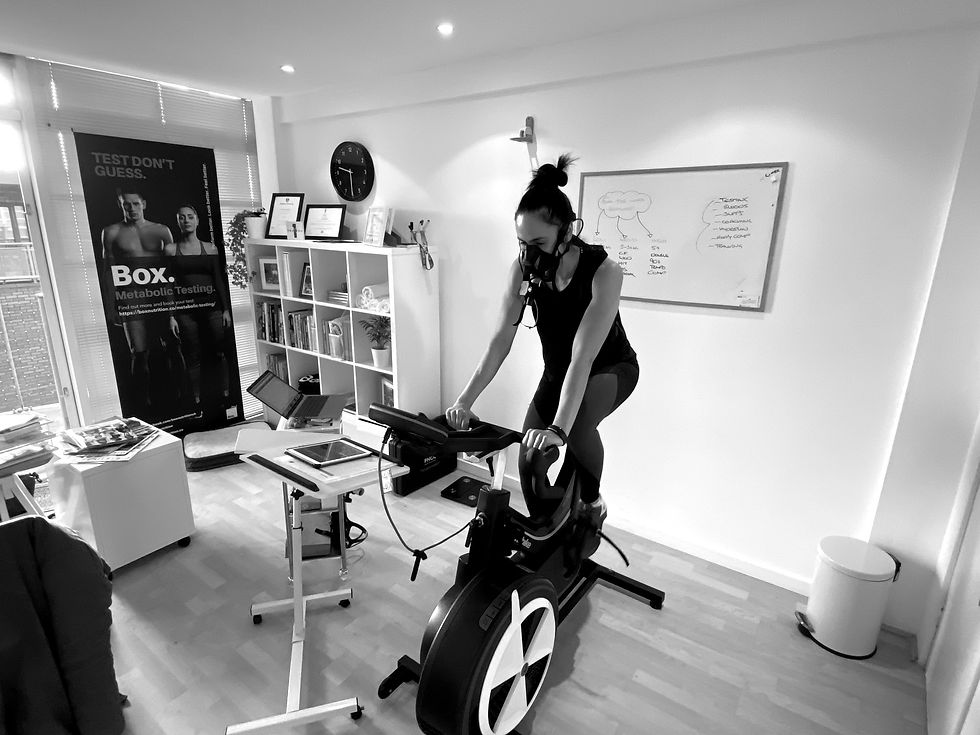What is your VO2max and how can you improve it?
- Jack Braniff
- Jul 22, 2020
- 4 min read
Updated: May 3, 2022

What is your VO2max and how can you improve it?
You’ve probably heard about it, but may not know exactly what it really means?
You may have seen someone bragging about theirs, or heard that knowing it is useless?
Either way, having an understanding of VO2max and how it relates to performance can help you maximise parts of your training. In this post I want to talk about what the VO2max is, how to test it and how you can improve it.
Ok so what is it?
Your VO2max is the maximum amount of oxygen that you can breathe in, transport to the working muscles and use per minute to produce energy. It’s essentially the size of your endurance engine and although not the only metric for success (http://www.boxnutrition.co.uk/single-post/the-five-fundamentals-of-endurance-performance), it is known as a key predictor of aerobic performance. A higher VO2max enables athletes to convert more oxygen to energy so you can push harder for longer.
Your VO2max is influenced by:
How much oxygen you can take on (lungs O2/breathing frequency)
How much blood you pump to you working muscles (stroke volume - o2 pulse)
How much oxygen you can extract (FeO2) and covert to energy - muscle fibre type/mitochondria density and function
How can you test it?

VO2max testing is performed using a metabolic cart which measures the oxygen you consume and the carbon dioxide you expire. During a short 10-20mins test intensity is gradually increased until the maximum oxygen uptake is achieved, which is measured in ml/kg/min.
As well as metabolic testing, the Cooper test (do you remember these from school???) can be used as a decent guess. This involves simply running as far as you can in 12 minutes. Then using the following equation you are able to estimate your VO2max:
Miles: VO2max = (35.97 x miles) - 11.29
Kilometers: VO2max = (22.351 x kilometers) - 11.288
How can you increase it?
There are a number of factors that influence your VO2max such as your age, sex, genetics, the training you’re currently doing, training status, muscle fibre and physiology. Although your VO2max potential comes down to picking your parents, in recreational and untrained individuals, we do see considerable improvements with the correct training. Increases in VO2max of elite and well trained populations however, is less potent.
Training to improve your VO2max
Any endurance training will help develop aspects of your VO2max, however we do know that polarising your sessions to target specific intensities can have a greater impact. This approach provides a powerful stimulus in developing the number and function of mitochondria, which are the power houses of your muscle cells that take up oxygen and help convert it to energy.

These two approaches are High Volume Training (HVT) and High Intensity Training (HIT). The combination of these training approaches can help:
Increase the size and number of mitochondria (in slow twitch fibres) with high volume training, which is the powerhouse of the muscle cell and where energy is produced
Increase the function of the mitochondria with VO2max intervals
Increase the number of capillaries surrounding the muscle, which will increase oxygen and glucose availability. This will also help get rid of lactate more quickly
Increase myoglobin so you can carry more oxygen to the muscles
Strengthen the heart, which increases stroke volume. This means more blood can get pumped around the body
Increased number of slow twitch muscle fibres (sustain space for longer distances)
Improved utilisation of fat as energy - use more fatty acids and spare glycogen for when you really need it.
Increased oxygen kinetics (less energy used to get up to race pace - less oxygen debt)
High Volume Training - This includes a number of hours spent in Zone 2 (around your aerobic/ventilatory threshold) and at a low intensity, below the point where you produce any lactate. This is because when you start producing lactate, it dampens the mechanisms that use fat as a fuel.
These sessions are typically <40 mins runs and <90mins rides.
High Intensity Training – This type of training can stimulate greater adaptations, however it be very taxing on the body. This is why a combination of this type of exercise and HVT compliments each other so well.
These HIT sessions to improve your VO2max are typically long intervals (2-4 mins) totalling 12-20mins with equivalent recovery times. Any longer than 4 minutes will mean you’re not hitting 95% of your VO2max and not targeting the desired intensity.
It’s not the only thing that matters
It’s important to note that your VO2max is measure of oxygen uptake, not speed or power, which are ultimately going to win you races. A higher VO2max often indicates your potential to be successful, but your performance will depend on other factors such as economy (amount of oxygen you need to run at a given pace), your ability to sustain your VO2max, fibre type, velocity at VO2max, nutrition and recovery will all be important. In fact Paula Radcliffe famously reduced her VO2max despite incredible improvements in her performance. This was put down to improvements in her running economy.
Test don’t guess
This is why VO2Max testing is such a useful tool to help with your running performance. As well as measuring your VO2max, we also measure your anaerobic threshold (ventilatory threshold 2/lactate threshold), aerobic threshold (top of zone 2) and carbohydrate/fat usage at different intensities. Having a better understanding of your body during exercise helps you identify weaknesses, pinpoint training zones as well as guide your training and fuelling strategies.
Are you interested to know more?
Further Reading
1. Endurance exercise performance >> https://www.ncbi.nlm.nih.gov/pmc/articles/PMC2375555/
2. Mitochondrion function vs content https://www.researchgate.net/publication/257838347_Can_we_optimise_the_exercise_training_prescription_to_maximise_improvements_in_mitochondria_function_and_content
3. Science and Application of High-intensity Interval Training: Solutions to the Programming Puzzle - https://www.amazon.co.uk/Science-Application-Intensity-Interval-Training/dp/1492552127










Comments